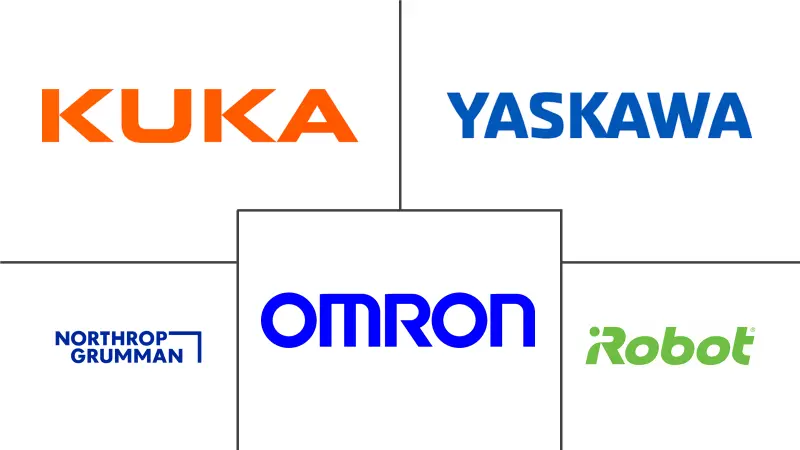Commercial Robotics Market Size and Share
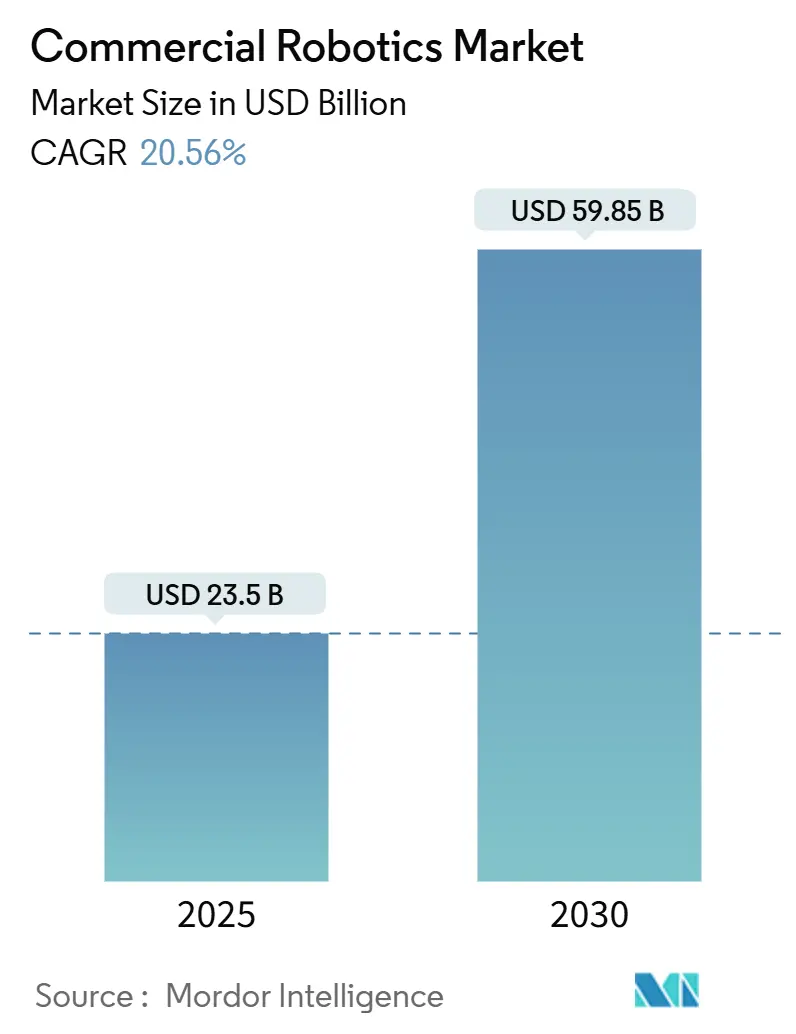
Commercial Robotics Market Analysis by Mordor Intelligence
The commercial robotics market size is valued at USD 23.50 billion in 2025 and is projected to register USD 59.85 billion by 2030, advancing at a 20.6% CAGR. Robust demand stems from the fusion of artificial intelligence with edge-computing hardware that allows robots to execute perception and manipulation tasks locally, trimming latency to single-digit milliseconds. Acute labor shortages continue to tighten across manufacturing and logistics, pushing automation budgets higher as companies look to fill a projected 8.5 million U.S. job gap by decade-end. Government procurement cycles further stimulate orders for defense and security platforms, while large e-commerce players deploy hundreds of thousands of mobile robots to compress fulfillment times. Concurrently, China’s state-backed USD 138 billion capital plan underscores Asia-Pacific’s accelerating demand for autonomous systems.[1]International Federation of Robotics, “State-Backed Robotics Funding in China,” ifr.org
Key Report Takeaways
- By component, hardware led with 66.5% of 2024 revenue; software is set to grow at 22.1% CAGR to 2030.
- By type of robot, drones accounted for 38.1% of 2024 revenue; medical robots represent the fastest-growing category at 21.3% CAGR to 2030.
- By application, defense and security held 32.4% of 2024 revenue, whereas agriculture and forestry is forecast to expand at a 20.7% CAGR through 2030.
- By mobility, mobile ground robots captured 57.8% share in 2024, while aerial robots are advancing at 21.8% CAGR through 2030.
- By geography, North America commanded 36.5% revenue in 2024; Asia-Pacific is projected to grow at 21.6% CAGR, supported by long-term Chinese investment commitments.
Global Commercial Robotics Market Trends and Insights
Drivers Impact Analysis
| Driver | (~) % Impact on CAGR Forecast | Geographic Relevance | Impact Timeline |
|---|---|---|---|
| Technological convergence of AI, edge computing and robotics | +4.2% | Global, concentrated in North America and China | Medium term (2-4 years) |
| Rising labor shortages and wage inflation | +3.8% | North America and EU, extending into APAC | Short term (≤ 2 years) |
| Expansion of e-commerce boosting warehouse robotics | +3.1% | Global, led by North America and China | Short term (≤ 2 years) |
| Increased government and defense spend on unmanned systems | +2.9% | Core markets in North America, EU, APAC | Medium term (2-4 years) |
| Eldercare service-robot adoption in super-aging economies | +2.4% | Japan, South Korea, Germany and select EU | Long term (≥ 4 years) |
| Regulatory fast-tracking of inspection robots | +1.8% | North America and EU with APAC spillover | Medium term (2-4 years) |
| Source: Mordor Intelligence | |||
Technological Convergence of AI, Edge Computing and Robotics
The commercial robotics market benefits from on-device AI inference that offsets cloud latency, enables split-second navigation choices, and supports generative task planning. Amazon operates more than 750,000 warehouse robots that deliver 25% efficiency gains by pairing vision models with local processing. John Deere's second-generation autonomy stack illustrates how edge AI permits centimeter-level steering in crop rows, enhancing uptime in unstructured fields. As advanced motion models mature, robots shift from rules-based motion to self-learning routines, turning capital equipment into upgradeable digital assets. This shift elevates software value and propels the commercial robotics market toward platform economics where algorithm improvements lift installed-base capability without mechanical retrofits.
Rising Labor Shortages and Wage Inflation
Manufacturers struggle to staff production lines as demographic shifts shrink labor pools. Vacancies could remove 2 million workers from U.S. factories by 2030, leading to an estimated USD 55 billion redirection of capital toward automation since 2021. Robotics mitigates repetitive and hazardous tasks, improving retention while sustaining throughput. As hardware prices have fallen to USD 10,856 per industrial robot, payback periods for mid-sized plants now average 1-3 years. Subscription financing models further lower entry barriers. Consequently, the commercial robotics market is positioned as a labor-augmentation tool rather than a displacement threat, aligning with corporate mandates to secure talent and productivity simultaneously.
Expansion of E-commerce Boosting Warehouse Robotics
Rapid-delivery expectations make automated fulfillment indispensable. Amazon’s USD 400 million North Andover facility combines predictive bin allocation with fleets of autonomous mobile robots to unload 700 cases per hour. DHL intends to add 1,000 Boston Dynamics units to a logistics network already running 200,000 smart devices, highlighting at-scale commercialization. Demand for intelligence that balances picker workloads and shortens cycle times links directly to revenue protection, embedding robotics in core operating models. Generative AI now recalculates route plans every few minutes, cutting travel distances and enabling profitable same-day shipping.
Increased Government and Defense Spend on Unmanned Systems
The U.S. Department of Defense earmarked USD 25.2 billion for AI and autonomy in FY 2025, tripling outlays since 2019. The Replicator initiative targets thousands of low-cost uncrewed assets by August 2025, catalyzing supplier ecosystems with dual-use spin-offs. Similar stimulus arises in China’s 14th Five-Year Plan, which fuses military and civil robotics development on a multi-decade horizon. Defense demand subsidizes high-reliability sensor suites subsequently commercialized in inspection, mining, and emergency-response applications, reinforcing growth across the broader commercial robotics market.
Restraints Impact Analysis
| Restraint | (~) % Impact on CAGR Forecast | Geographic Relevance | Impact Timeline |
|---|---|---|---|
| High up-front cost of robotic systems | -2.8% | Global, intense for SMEs in developing markets | Short term (≤ 2 years) |
| Cyber-security vulnerabilities in connected robots | -1.9% | Global, critical infrastructure sectors | Medium term (2-4 years) |
| Supply-chain risk for rare-earth permanent magnets | -1.6% | Global, sharp for precision manufacturers | Long term (≥ 4 years) |
| Shortage of skilled integrators and technicians | -1.4% | Primarily North America and EU, expanding globally | Medium term (2-4 years) |
| Source: Mordor Intelligence | |||
High Up-front Cost of Robotic Systems
Total deployment budgets still top USD 100,000 once integration and training are included, delaying adoption for smaller firms. Robot-as-a-Service contracts help flatten capital curves by bundling equipment, software, and maintenance into monthly fees. Tennant’s USD 32 million agreement with Brain Corp underpins 6,500 autonomous cleaning units already in service, proving subscription models in facility care. Modular designs and standardized interfaces aim to trim engineering hours, but ecosystem tooling remains nascent, especially in emerging economies where integrator networks are thin.
Cyber-security Vulnerabilities in Connected Robots
Robots linked into operational technology networks expand the attack surface. Studies using Random Forest classifiers identify firmware exploitation as the dominant threat path, calling for IEC 62443 compliance throughout design and deployment. The EU’s NIS2 directive raises mandatory safeguards, adding cost layers that may slow orders until vendors certify hardened architectures. TÜV Rheinland advises integrating security by design, but many installers still treat cyber-hardening as a post-commissioning add-on, risking downtime and reputational damage.
Segment Analysis
By Component: Hardware Dominance Faces Software Disruption
Hardware generated 66.5% of 2024 revenue, underscoring the capital intensity of actuators, drives, and sensor payloads that form each robotic platform’s physical backbone. Yet software posted a 22.1% CAGR, reflecting enterprise migration toward intelligence-defined value. Over 80% of ABB’s portfolio now bundles AI features that enable real-time path planning, dynamic force control, and digital twin-based simulation. Services contributed residual revenue but are widening as installed bases mature.
Software gains illustrate a strategic pivot. As hardware components commoditize, algorithm stacks dictate differentiation. Amazon’s tactile-sensor-equipped Vulcan robot moves 75% of stock-keeping units once reserved for human pickers, a feat impossible without advanced gripping software. Consequently, the commercial robotics market size for software is projected to outpace mechanical build spend by late decade, reshaping supplier power balances and enabling subscription monetization.

Note: Segment shares of all individual segments available upon report purchase
By Type of Robot: Drones Lead While Medical Robots Surge
Drones accounted for 38.1% of 2024 turnover, buoyed by inspection, mapping, and last-mile delivery services authorized under FAA Part 108 rules that permit beyond-visual-line-of-sight flights.[2]Federal Register, “Part 108: Rules for Beyond-Visual-Line-of-Sight UAV Operations,” federalregister.gov Medical platforms posted the swiftest rise at 21.3% CAGR, with hospitals installing additional da Vinci systems to satisfy minimally invasive procedure demand. Intuitive Surgical recorded USD 2.25 billion Q1 2025 revenue on a 15% system-base expansion.
The category shift underscores healthcare’s appetite for precision and demographic-driven eldercare requirements. Meanwhile, field robots demonstrate traction in agriculture and construction, while autonomous guided vehicles dominate structured industrial pathways. Portfolio diversity signals that the commercial robotics market will rely on multi-modal platform growth rather than single-category dominance.
By Application: Defense Leads, Agriculture Accelerates
Defense and security platforms secured 32.4% of 2024 revenue, anchored by multi-year procurement contracts and readiness mandates. Agriculture and forestry posted a 20.7% CAGR, propelled by autonomous tractors that cultivate over 50,000 acres with centimeter precision. Medical, warehouse, and marine applications round out demand as each sector leverages autonomy to offset labor constraints.
Agriculture’s acceleration reflects growers’ need to bridge a 2.4 million labor deficit while managing input costs and sustainability targets. Vision-guided implements can target weeds with selective spraying, reducing herbicide use 80% and improving environmental compliance. As regulatory bodies finalize frameworks for field robot safety, the commercial robotics market anticipates rapid scale-out across row crops and specialty produce.
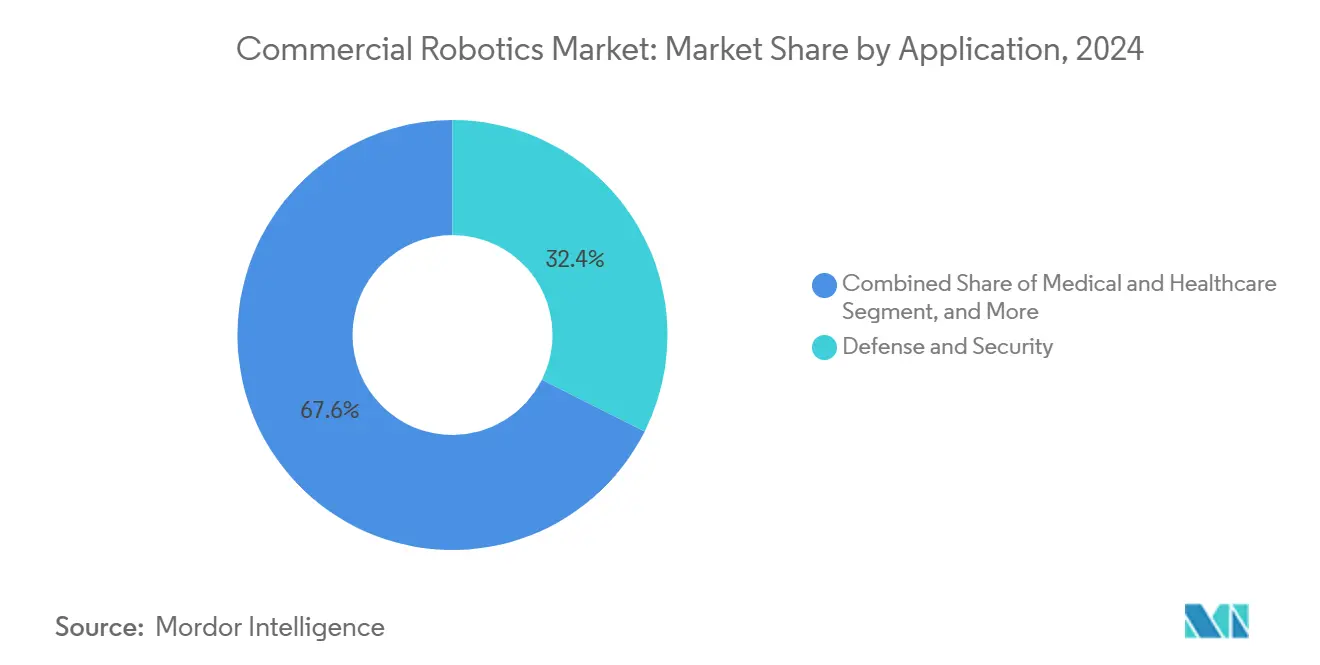
Note: Segment shares of all individual segments available upon report purchase
By Mobility: Mobile Ground Robots Dominate
Mobile ground robots held 57.8% share in 2024, favored for factory, retail, and airport logistics where existing floor layouts support autonomous navigation. Aerial robots, however, are advancing at a 21.8% CAGR as battery densities climb and regulatory thresholds ease. American Robotics received an FAA waiver that eliminates visual observers, a milestone that slashes operating cost per flight-hour.
Stationary robotic arms remain vital for high-precision assembly, while underwater vehicles such as Nauticus Robotics’ Aquanaut Mk2 cut greenhouse gas emissions in offshore inspection by replacing crewed vessels. This mixed-mobility landscape reinforces the commercial robotics market outlook, ensuring that capex is spread across varied locomotion form factors.
Geography Analysis
North America retained 36.5% revenue leadership in 2024, driven by defense outlays and hyperscale e-commerce deployments that utilize extensive autonomous fleets. Funded research programs and venture capital clusters accelerate commercialization cycles, enabling rapid transition from pilot projects to full plant-scale installations. Technology exports from Silicon Valley further support platform standardization in Canada and Mexico.
Asia-Pacific posts the steepest trajectory at 21.6% CAGR through 2030. China's pledge to inject nearly USD 138 billion backs industrial robot supply chains, raising indigenous supplier share from 30% to 47% between 2020 and 2023. National plans in Japan and South Korea collectively allocate more than USD 1 billion for humanoid and manufacturing-grade robots, channeling public-private partnerships into commercialization. Rapid urbanization and wage escalations across Southeast Asia further cultivate adoption among local manufacturers seeking productivity gains.
Europe remains a mature but innovation-active market, combining established automotive automation with stringent safety standards. The region's fit-for-55 emissions plan favors service robots that optimize energy and waste footprints. Middle East and Africa and South America remain nascent, constrained by integrator scarcity and limited financing. Nonetheless, port automation projects and mining robots are slowly catalyzing pilot orders that foreshadow longer-term demand.
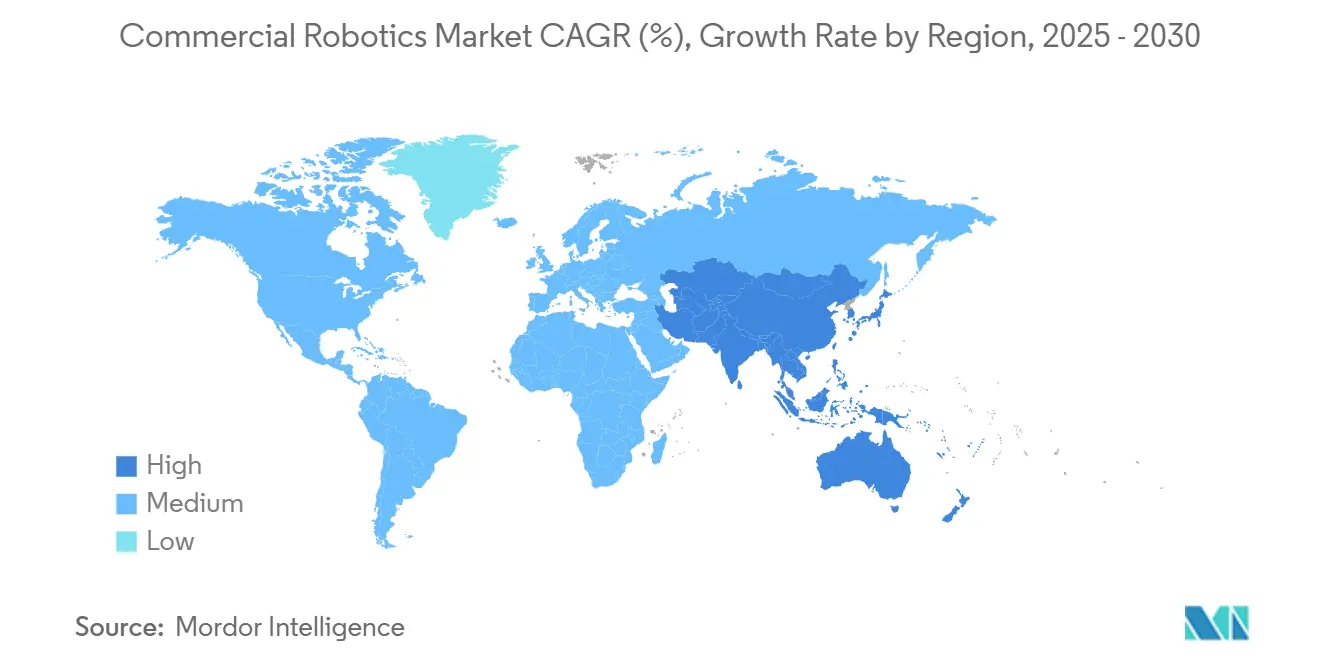
Competitive Landscape
The commercial robotics market shows moderate fragmentation as legacy automation vendors, AI-native startups, and vertically integrated tech conglomerates contest share. ABB, FANUC, and KUKA face margin compression amid software-centric business models, prompting ABB to pursue a USD 2.3 billion spin-off to sharpen focus.[3]ABB, “Software Share in Robotics Portfolio Surpasses 80%,” abb.com FANUC’s 16% slide in industrial robot shipments signals that low-code rivals are encroaching on traditional volume segments.
Technology giants leverage internal use cases as commercialization bases. Amazon’s warehouse fleets generate operating data that shortens product-development cycles, while Alphabet’s Intrinsic repurposes humanoid capabilities originally incubated inside Google X. Automotive OEMs pursue vertical moves: Hyundai completed its USD 1.1 billion Boston Dynamics acquisition, pairing robotics with electric-vehicle manufacturing synergies.
Emerging specialists focus on niche adjacencies. Apptronik collaborates with Jabil to mass-produce Apollo humanoids, targeting high-mix manufacturing cells with dexterous handling requirements. Nauticus Robotics applies subsea autonomy to reduce offshore inspection emissions, winning pilot engagements with global energy operators. These strategic pockets highlight room for differentiated value propositions even as consolidation pressures rise.
Commercial Robotics Industry Leaders
-
Yaskawa Electric Corporation
-
Northrop Grumman Corporation
-
Kuka AG
-
iRobot Corporation
-
Omron Adept Technologies Inc.
- *Disclaimer: Major Players sorted in no particular order
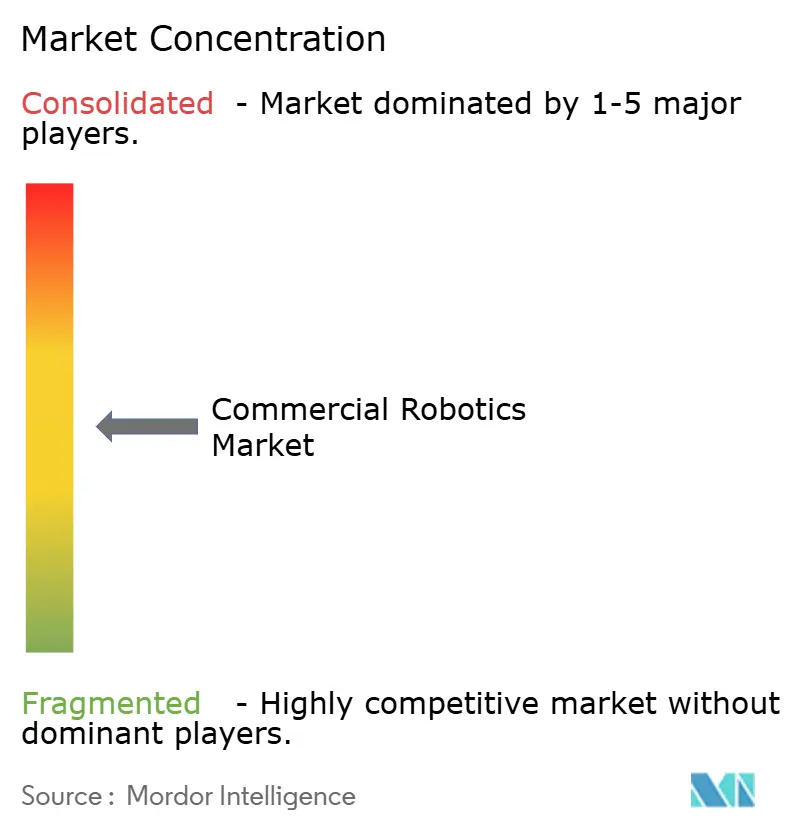
Recent Industry Developments
- May 2025: DHL Group signed a memorandum of understanding with Boston Dynamics to deploy an additional 1,000 robots, building on a network already running 7,500 robots and 200,000 smart devices.
- May 2025: Amazon introduced the Vulcan warehouse robot with tactile sensing to handle 75% of stock units previously managed manually, operating up to 20 hours daily.
- April 2025: ABB revealed plans to spin off its USD 2.3 billion robotics division as a separate listed entity by Q2 2026.
- February 2025: Apptronik and Jabil announced a strategic collaboration to scale production of Apollo humanoid robots for manufacturing, retail, and elder-care deployment.
Global Commercial Robotics Market Report Scope
Robotics play a crucial role in commercial applications, with many core operations being managed by robots. The commercial robotics market has witnessed a surge in demand in the past decade. This is due to the rising convergence of robotics and artificial intelligence, including planning and search, probabilistic inference, localization, tracking, and control.
The Commercial Robotics Market is Segmented by Type of Robot (Drones, Field Robots, Medical Robots, Autonomous Guided Robotics), Application (Medical and Healthcare, Defense and Security, Agriculture and Forestry, Marine), and Geography (North America, Europe, Asia Pacific, Latin America, MEA). The market sizes and forecasts are provided in terms of value (USD million) for all the above segments. The report also covers the trends in the market and the assessment of the impact of COVID-19 on the market.
| Hardware |
| Software |
| Services |
| Drones / UAVs |
| Field Robots |
| Medical Robots |
| Autonomous Guided Robots |
| Other Types |
| Medical and Healthcare |
| Defense and Security |
| Agriculture and Forestry |
| Marine and Offshore |
| Warehousing and Logistics |
| Other Applications |
| Stationary Robots |
| Mobile Ground Robots |
| Aerial Robots |
| Marine / Underwater Robots |
| North America | United States | |
| Canada | ||
| Mexico | ||
| Europe | Germany | |
| United Kingdom | ||
| France | ||
| Italy | ||
| Spain | ||
| Rest of Europe | ||
| Asia-Pacific | China | |
| Japan | ||
| India | ||
| South Korea | ||
| Australia | ||
| Rest of Asia-Pacific | ||
| South America | Brazil | |
| Argentina | ||
| Rest of South America | ||
| Middle East and Africa | Middle East | Saudi Arabia |
| United Arab Emirates | ||
| Turkey | ||
| Rest of Middle East | ||
| Africa | South Africa | |
| Egypt | ||
| Nigeria | ||
| Rest of Africa | ||
| By Component | Hardware | ||
| Software | |||
| Services | |||
| By Type of Robot | Drones / UAVs | ||
| Field Robots | |||
| Medical Robots | |||
| Autonomous Guided Robots | |||
| Other Types | |||
| By Application | Medical and Healthcare | ||
| Defense and Security | |||
| Agriculture and Forestry | |||
| Marine and Offshore | |||
| Warehousing and Logistics | |||
| Other Applications | |||
| By Mobility | Stationary Robots | ||
| Mobile Ground Robots | |||
| Aerial Robots | |||
| Marine / Underwater Robots | |||
| By Geography | North America | United States | |
| Canada | |||
| Mexico | |||
| Europe | Germany | ||
| United Kingdom | |||
| France | |||
| Italy | |||
| Spain | |||
| Rest of Europe | |||
| Asia-Pacific | China | ||
| Japan | |||
| India | |||
| South Korea | |||
| Australia | |||
| Rest of Asia-Pacific | |||
| South America | Brazil | ||
| Argentina | |||
| Rest of South America | |||
| Middle East and Africa | Middle East | Saudi Arabia | |
| United Arab Emirates | |||
| Turkey | |||
| Rest of Middle East | |||
| Africa | South Africa | ||
| Egypt | |||
| Nigeria | |||
| Rest of Africa | |||
Key Questions Answered in the Report
What is the projected value of the commercial robotics market by 2030?
The market is forecast to reach USD 59.85 billion by 2030.
Which application currently leads the commercial robotics market?
Defense and security platforms lead, accounting for 32.4% of 2024 revenue.
Why is Asia-Pacific expected to be the fastest-growing region?
Asia-Pacific benefits from China’s long-term USD 138 billion investment plan and expanding manufacturing automation.
How quickly are software revenues growing within the commercial robotics market?
Software is expanding at a 22.1% CAGR, outpacing hardware as AI capabilities become central to customer value.
What is the largest mobility segment in the commercial robotics market?
Mobile ground robots dominate with 57.8% share, driven by widespread warehouse and factory adoption.
How are high up-front costs being mitigated for smaller enterprises?
Robot-as-a-Service contracts and modular, standardized integration platforms are reducing initial capital expenditure and deployment complexity.
Page last updated on:
